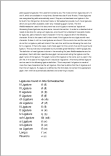|
Good text output relies one ligatures which are available in many
fonts. The most common ones are 'fi', 'ff', 'fl', 'ffi', and 'ffl'.
Those are recognized by pslib automatically and used if the font
has the glyphs for them. Many old german fonts like 'Alte Schwabacher'
has many more ligatures, which may either be declared in the Adobe
Font Metrics file or manually by a so called encoding file. The font
used in this example is very broken. It does not declare any ligatures
and spills the glyphs of the ligatures all over the fontencoding vector.
Manual work had to be done to fix. Read the text of the example for
some more information.
|

|
